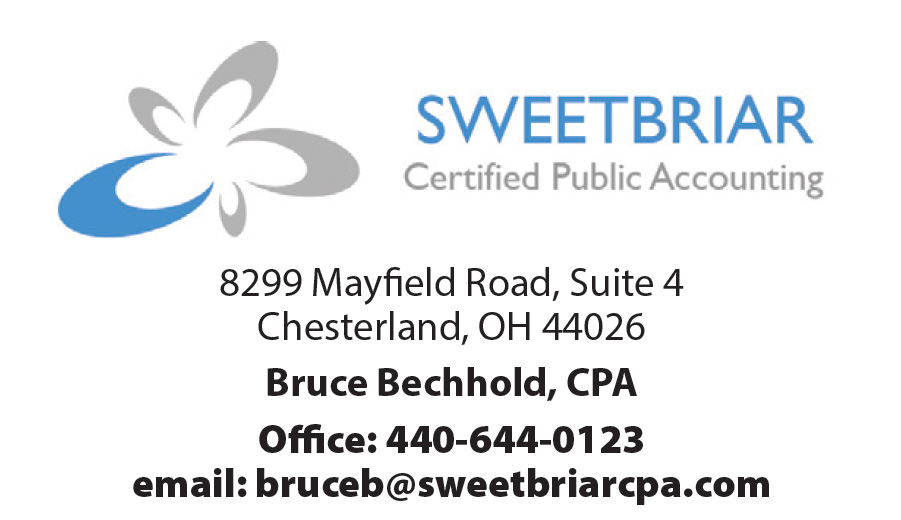 Bruce Bechhold, CPA, is committed to helping business owners with their tax, accounting, and business needs. His goal is to help clients grow their company, understand their financial statements, and reduce their tax exposure. Contact Bruce at 440-644-0123 or bruceb@sweetbriarcpa.com.
Bruce Bechhold, CPA, is committed to helping business owners with their tax, accounting, and business needs. His goal is to help clients grow their company, understand their financial statements, and reduce their tax exposure. Contact Bruce at 440-644-0123 or bruceb@sweetbriarcpa.com.
By Bruce Bechhold, CPA
You can figure it out on your own, or you can hire a professional who fully understands the tax laws and opportunities, so you avoid costly mistakes and missed opportunities. Also, keep in mind that CPAs have unlimited representation rights before the IRS. Here are a few highlights to consider when thinking about preparing your own tax return.
No. 1 — Maximize the qualified business income deduction
Perhaps the hottest topic of the Tax Cuts and Jobs Act is the new qualified business income deduction under Section 199A. Individuals who own interests in a sole proprietorship, partnership, LLC, or S corporation may be able to deduct up to 20 percent of their qualified business income. However, the deduction is subject to various rules and limitations. You definitely want to consult your CPA to ensure you take advantage of this provision.
No. 2 — Bunch charitable contributions
The new law temporarily increases the limit on cash contributions to public charities and certain private foundations from 50 to 60 percent of adjusted gross income. However, the doubling of the standard deduction and changes to key itemized deductions will prevent some taxpayers from itemizing in 2018 and therefore, benefiting from this increased limit. One way to combat this is to bunch charitable contributions in alternating years when you itemize and take the increased standard deduction in the other years.
No. 3 — Watch out for home equity debt interest
As I wrote about in the last issue, according to the IRS, interest paid on home equity loans and lines of credit is deductible if the funds were used to buy or substantially improve the home that secures the loan. In other words, it’s treated as home acquisition debt subject to the new $750,000/$375,000 limit. This is good news for homeowners, but it forces you to trace how the proceeds were used. If you used the cash to pay off credit card or other personal debts, the interest isn’t deductible, even if the payoff occurred prior to 2018.
No. 4 — Revisit your qualified tuition plans
Qualified tuition plans, also called 529 plans, are a great way to ease the financial burden of paying for college. Before the Tax Cuts and Jobs Act, earnings in a 529 plan could be withdrawn tax-free only when used for qualified higher education at colleges, universities, vocational schools or other post-secondary schools. Thanks to the Tax Cuts and Jobs Act, 529 plans can now be used to pay for tuition at an elementary or secondary public, private or religious school, up to $10,000 per year!
No. 5 — Itemized deductions versus the standard deduction
The Tax Cuts and Jobs Act roughly doubles the standard deduction. This means that for 2018, joint filers can take a standard deduction of $24,000. However, the new law suspends personal exemption deductions and eliminates or limits many of the itemized deductions. The state and local tax deduction is now capped at $10,000 per year, or $5,000 for a married taxpayer filing separately. Also, the Tax Cuts and Jobs Act temporarily eliminates miscellaneous itemized deductions subject to the 2 percent floor (like tax preparation fees and employee business expenses) and limits the home mortgage interest deduction to home acquisition debt of up to $750,000, or $375,000 for a married taxpayer filing separately.
So, what does all of this mean for you? For those who typically claim the standard deduction, chances are their tax bill will decrease for 2018. Although personal exemption deductions are no longer available, a larger standard deduction, combined with lower tax rates and an increased child tax credit, may result in less tax.
So you can figure it out on your own, or you can hire a professional who fully understands the tax laws and opportunities so you avoid costly mistakes and missed opportunities.
























